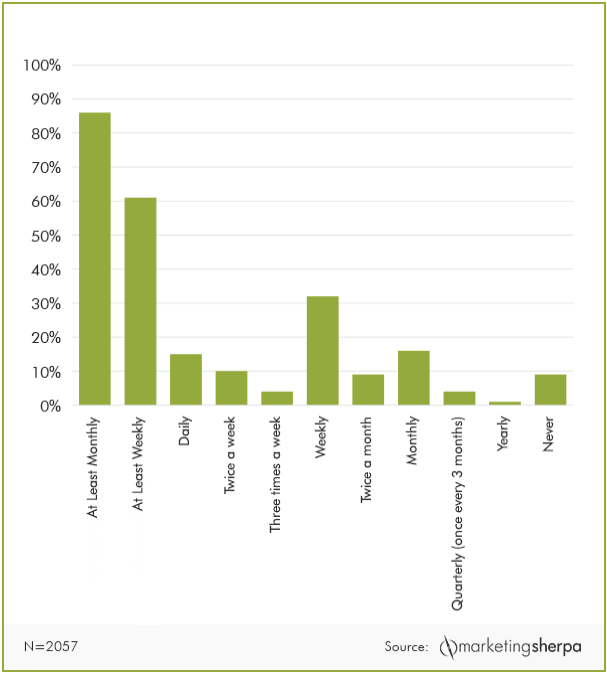
Email is hands down the most valuable marketing channel Ecommerce businesses have for connecting with current and prospective customers. According to research from the Direct Marketing Association, email has an average ROI of $38 for every $1 spent. That’s more than any other marketing channel. Hint: if you haven’t started building an email list yet, here’s your reminder to start.
I’m sure most of you are already doing some form of email marketing, but let’s look at few different ways that you can squeeze more revenue from your email list.
Send More Email
This might seem counterintuitive. Marketers and business owners are often afraid of coming off as “spammy” if they send too much email. But how much is too much? If you’re only emailing once a month or less, data from MarketingSherpa suggests you should reconsider your approach.

What should you do? Take a four week period of time and run a test. Send one promotional email each week and analyze the results. Measure the open rate, click through, unsubscribe rates, and most importantly, sales.
Just be sure you’re following email marketing best practices like sending relevant messages. If you’re sending email just to send email, it won’t work. You need to invest some time in this and make sure each email is the best that it can be.
Experiment with Segmentation
Are you still sending the same messages to all of your subscribers? If you are, it’s time to revise that approach and get creative with segmentation.
If you’re unfamiliar with the term, segmentation simply means breaking your list into segments based on criteria like age, location of residence, or purchase history. This allows you to create messages that are highly targeted and relevant to the recipient. In doing so, you should see better performance.
Here are a few examples of how you could segment your list:
- Send emails more frequently to subscribers that open or clickthrough your emails at a higher rate than other subscribers
- Use past purchase history to send emails promoting complementary products to different segments
- Send promotional emails with a larger incentive to subscribers that haven’t purchased from you yet or haven’t purchased in several months
The ways that you can segment your list are only limited by the amount of data you collect about your subscribers and import into your email marketing tool. You should experiment with segmentation until you hit on the combination of factors that works for your goal.
Resend Emails
This might seem obvious but few retailers think about it. If you’re averaging a 40% open rate on your email sends, that means 60% of people are not reading your emails. A simple way to solve the problem is to wait a few days, and resend the email to only those that did not open it.
It’s unlikely that everyone will open your second email, but some will and increasing your overall open rate from 40% for the email to 65% is nothing to sneeze at.
Retarget Your List With Display Ads
This tip is a little more advanced, as it involves integrating several technologies, but it can pay dividends. You’ve almost certainly experienced retargeting in the past. Think back to a time when you visited a retailer’s website, but left without buying anything. Did you notice that ads for that retailer and/or the products you were looking at started following you around on other websites? That’s retargeting.
For our purposes, the overall goal of retargeting is similar to the above tip to resend emails to non-openers. You’re trying to tap into the segment of your email list that’s not reading your emails. If you’re using a popular email marketing tool like MailChimp, it likely integrates with one of the many retargeting platforms out there like AdRoll of Perfect Audience.
Once you set up the integration between the platforms, you’ll just create a segment in your email marketing tool comprised of people that haven’t opened a few of your recent email sends. Then set up your retargeting platform to target those users with display ads.
The ad content is up to you, but I suggest you start by either broadly promoting your brand, promoting a current sale, or by promoting some of your top selling products. You can also repeat the process for your more active subscribers.
Obviously, this is just the tip of the proverbial iceberg with what you can do with email and retargeting. Just like with segmentation, I encourage you to experiment!
Start A|B Testing
Starting with some simple A|B testing is a great way to improve your overall email marketing, which should make you more money. The basics of A|B testing are as follows:
- Identify an email metric you want to improve. For this example, let’s use open rate.
- Form a hypothesis: If I do X, my open rate will improve. For this example, let’s say “If I include the recipient’s first name in the subject line, my open rate will improve.”
- Split a reasonably large segment of your list, say people that have bought from you in the past, into two equally sized segments (A and B)
- Send segment A a version of your email where the subject line doesn’t include the recipient’s first name
- Send segment B the same email, but include the recipient’s first name in the subject line
- Measure the results and analyze them against your hypothesis
If segment B had a higher open rate than segment A, you can make a reasonable assumption that your hypothesis was correct. Including first name in subject lines will result in a higher open rate than if you don’t.
The great thing about A|B testing is that it’s a general framework that you can apply to almost any aspect of your email marketing. You can test the body of the email to improve your clickthrough rate, you can test the segments you send your email to and see if that affects overall performance. The list is endless.
You should note that A|B testing methodology can get pretty complex and there are concepts like sample size and statistical significance that you should bear in mind before calling a test a success or a failure, but that shouldn’t stop you from getting started. Run a few simple tests and I think you’ll be impressed with the results.
For more info on A|B I suggest referring to ConversionXL. It’s a great resource on all things A|B testing and conversion rate optimization.
I hope you enjoyed this post. If you did, be sure to share it on Facebook, Twitter, or LinkedIn. We really appreciate the support!
Zoey is a powerful Ecommerce platform that helps entrepreneurs build and scale online businesses. It integrates with MailChimp amongst other marketing tools, so you can apply all of the above tips with ease. Try Zoey free for 14 days by clicking the button below!





